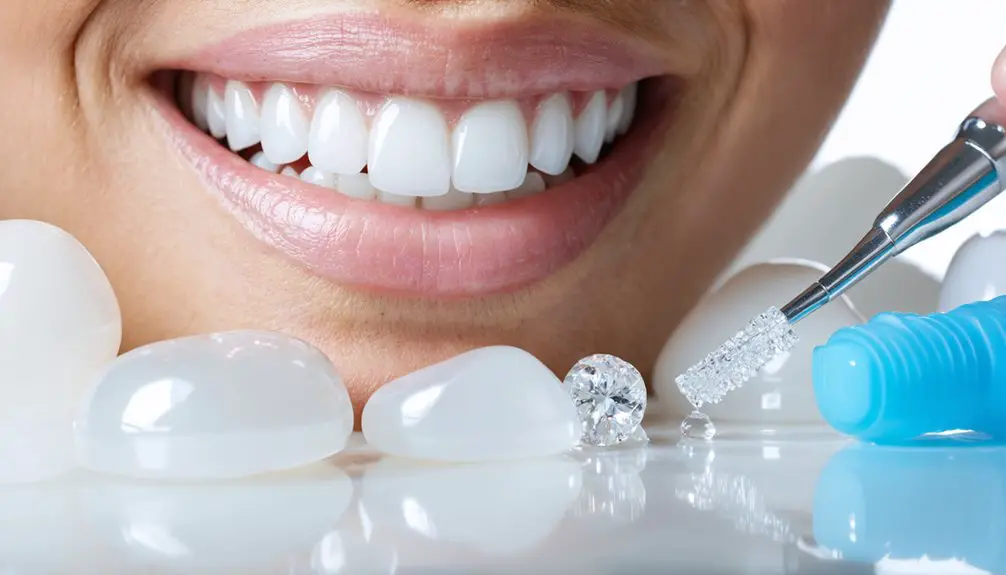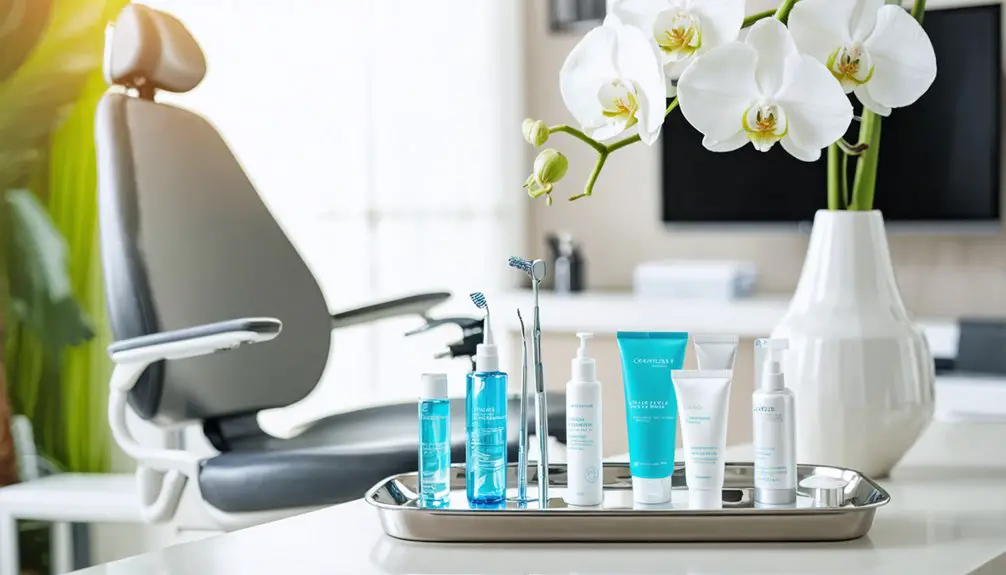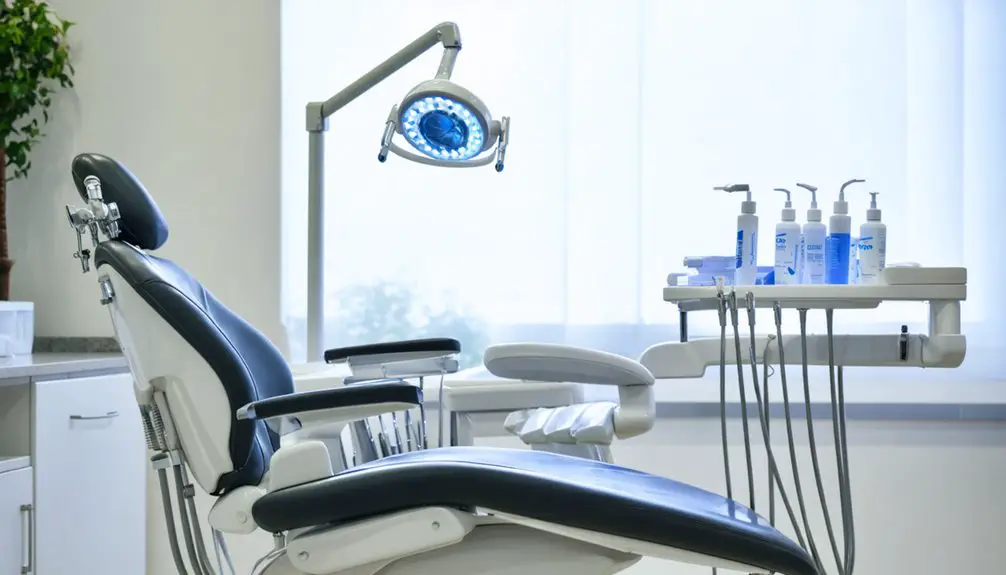You’ll get the best professional teeth whitening results by preparing properly and following key aftercare steps. Start using desensitizing toothpaste a week before treatment, schedule a dental cleaning to remove surface stains, and maintain thorough oral hygiene. After treatment, stick to room-temperature foods for 48 hours and avoid staining beverages like coffee and wine. Following these gentle techniques will help you achieve up to eight shades lighter while minimizing sensitivity – and there’s much more to explore about maximizing your results.
Key Takeaways
- Start using desensitizing toothpaste one week before treatment to minimize discomfort and prepare teeth for the whitening process.
- Schedule a professional cleaning before whitening to remove surface stains and ensure optimal treatment effectiveness.
- Choose custom-fitted trays to prevent gel contact with gums and reduce sensitivity during professional whitening sessions.
- Follow a white diet for 48 hours post-treatment, avoiding dark-colored foods and beverages to maintain results.
- Use room-temperature foods and calcium-rich products after treatment while continuing with desensitizing products for best results.
Understanding Your Whitening Options
When it comes to teeth whitening, understanding your available options is essential for achieving the best results for your smile. Despite common whitening myths, both professional and at-home treatments can effectively brighten your teeth, though they differ considerably in strength and longevity.
Professional treatments like laser and Zoom whitening use high-concentration peroxide (25-44%) activated by specialized light technology, delivering dramatic results in single sessions. Fruit enzymes and charcoal have emerged as natural alternatives for those seeking eco-conscious whitening solutions. You’ll typically see up to 8 shades lighter with results lasting 1-3 years. Mild tooth sensitivity may occur temporarily after professional treatments.
Professional teeth whitening delivers powerful, long-lasting results through concentrated peroxide treatments activated by advanced light technology.
For more gradual treatment expectations, at-home options include LED kits, custom trays, and whitening strips with lower peroxide concentrations around 10%. While these require consistent use over time, they’re more affordable and can still produce noticeable improvements.
Your choice should align with your desired outcome, timeline, and budget.
Pre-Treatment Care and Preparation
Proper preparation before teeth whitening greatly impacts your treatment’s success and comfort. Start by scheduling a dental consultation to assess your candidacy and establish realistic expectations.
Begin using desensitizing toothpaste a week before treatment to minimize sensitivity during the process. Verify with your dentist that you have no untreated cavities that could interfere with the whitening treatment.
Maintain thorough oral hygiene, including regular brushing, flossing, and preparing mouthwash rinses to create an ideal environment for whitening.
Book a professional cleaning to remove stubborn tartar and surface stains. Eating crunchy fruits and vegetables can help naturally clean teeth between professional cleanings.
Focus on dietary hydration and avoid staining substances like coffee, tea, and red wine for at least 48 hours before treatment. If you must consume these beverages, use a straw to minimize contact with your teeth.
On treatment day, brush gently, apply lip balm, and eat beforehand, as you’ll need to restrict food intake afterward.
Managing Tooth Sensitivity
If you’re concerned about tooth sensitivity during whitening, you’ll want to take preventive steps before beginning treatment, such as using desensitizing products containing potassium nitrate or fluoride.
During the whitening process, you can minimize discomfort by following your dentist’s instructions precisely regarding treatment duration and frequency of applications. Using a soft-bristled toothbrush can help reduce irritation to sensitive teeth and gums. Modern whitening treatments often include anti-sensitivity agents to enhance patient comfort.
After whitening, protect your teeth by avoiding extremely hot or cold foods, using fluoride products to aid remineralization, and maintaining proper oral hygiene.
Minimize Pain During Treatment
Though teeth whitening can deliver stunning results, managing sensitivity during treatment is essential for a comfortable experience. You’ll find significant relief by using desensitizing agents before your treatment begins.
Apply specialized gels containing 5% potassium nitrate to block pain signals, and consider using hydroxyapatite toothpaste two weeks prior to create a protective barrier around your teeth.
For effective pain management during the process, take over-the-counter pain relievers before treatment, and opt for professional supervision to guarantee proper application techniques. Studies show that treatments using 35% hydrogen peroxide consistently cause tooth sensitivity, making lower concentrations a safer choice.
Choose custom-fitted trays to prevent gel contact with your gums, and maintain consistent use of desensitizing toothpaste throughout your whitening journey. The mineral restoration process typically takes several days as your teeth recover from treatment.
Leave the toothpaste on your teeth for several minutes before rinsing to maximize its protective benefits.
Prevention Before Starting
Taking preventive steps before teeth whitening can dramatically reduce sensitivity and guarantee a more comfortable experience.
Start by scheduling a pre-whitening evaluation with your dentist to assess your oral health and receive customized treatment recommendations. You’ll want to begin using desensitizing toothpaste containing potassium nitrate at least two weeks before treatment. Custom-fitted trays can help prevent gum irritation during at-home whitening treatments. Hard bristles can damage enamel and increase sensitivity, so use soft-bristled toothbrushes only.
Focus on enamel protection by maintaining excellent oral hygiene and avoiding acidic foods and beverages.
Switch to fluoride toothpaste and brush gently to prevent enamel erosion. Incorporate calcium-rich foods into your diet to strengthen teeth, and stay hydrated with neutral pH water.
If you’re particularly sensitive, your dentist may apply professional desensitizing gels that create a protective barrier before the whitening procedure begins.
Post-Whitening Care Strategies
Managing tooth sensitivity after whitening requires a strategic combination of desensitizing agents and dietary modifications. You’ll need to maintain consistent post-whitening routines, including twice-daily use of desensitizing toothpaste containing potassium nitrate or hydroxyapatite. These ingredients help block nerve pathways and form protective barriers on your teeth.
For ideal enamel care, stick to room-temperature foods and beverages for 48 hours post-treatment. Avoid acidic, sugary items that can increase sensitivity, and instead choose calcium-rich foods like yogurt and cheese to support mineral replenishment.
If discomfort occurs, you can use over-the-counter pain relievers proactively. Remember that most sensitivity resolves within a week as minerals naturally restore in your enamel, but continue using desensitizing products throughout this period for best results.
Selecting the Right Professional Treatment
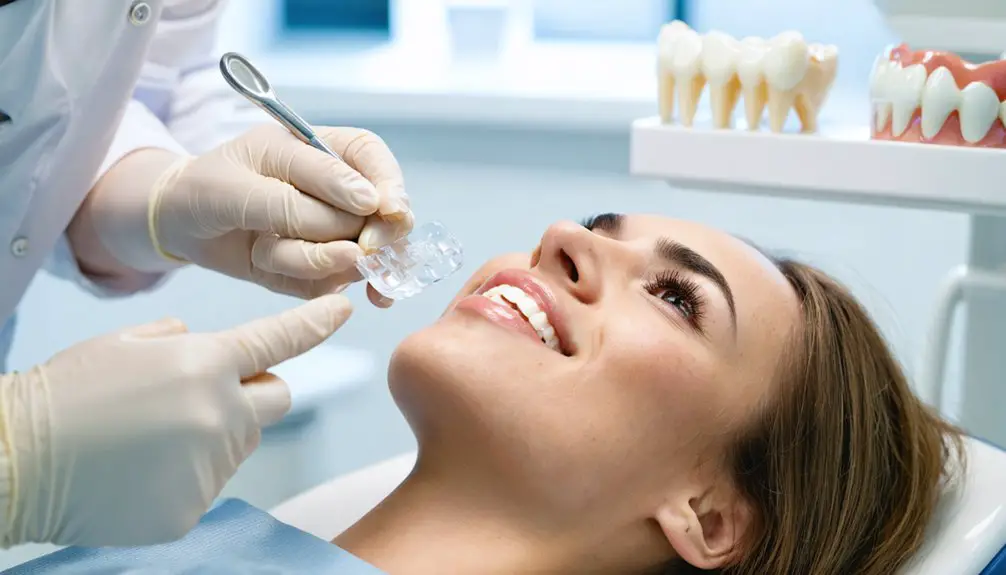
When choosing a professional teeth whitening treatment, you’ll find options ranging from in-office laser procedures to custom take-home trays, each offering different balances of convenience and effectiveness.
Your dentist’s pre-treatment assessment will determine which method best suits your specific needs while ensuring your oral health can support the chosen procedure.
While in-office treatments like Zoom Whitening provide dramatic results in a single visit, take-home professional options offer a more gradual approach that can be equally effective with consistent use.
Treatment Types Explained
If you’re considering professional teeth whitening, understanding the available treatment types can help you make an informed decision.
In-office treatments offer powerful bleaching with hydrogen peroxide or carbamide peroxide, activated by LED or laser technology for dramatic same-day results. Treatment comparisons show that Zoom Whitening can lighten teeth up to eight shades in just 90 minutes.
For more gradual whitening, your dentist can provide custom-fitted trays with professional-grade gel for at-home use.
Application techniques vary between treatments, with some combining in-office sessions and take-home maintenance options. While in-office procedures deliver immediate results under expert supervision, professional take-home kits offer a more flexible approach with custom trays that guarantee uniform coverage.
Each method provides stronger, longer-lasting results than over-the-counter alternatives.
Safety vs. Results
Professional teeth whitening requires careful consideration of both safety and desired results. Your dentist will evaluate your enamel thickness, existing restorations, and oral health to determine the most appropriate treatment approach.
While higher peroxide concentrations (25-40%) deliver superior whitening effectiveness, they also require proper safety measures to prevent sensitivity and tissue irritation.
You’ll achieve the best balance between results and protection through supervised professional treatments that include gum barriers and precise application techniques. If you have sensitive teeth, your dentist can incorporate desensitizing agents and adjust peroxide levels accordingly.
For ideal long-term success, consider combining an initial in-office treatment with monthly at-home maintenance, which maximizes whitening while minimizing potential risks to your dental health.
Professional Assessment Benefits
Before undertaking any teeth whitening treatment, a thorough professional assessment guarantees you’ll receive the most effective and safest approach for your specific needs.
During your professional evaluation, your dentist will examine existing dental conditions, measure tooth sensitivity, and document your current tooth shade using specialized diagnostic tools.
This detailed assessment enables precise treatment customization, including selecting ideal bleaching concentrations and application methods tailored to your oral health status.
Your dentist will evaluate any existing dental work, such as crowns or veneers, which don’t respond to whitening treatments, ensuring realistic expectations.
They’ll also consider your lifestyle factors and dietary habits to recommend the most suitable whitening protocol, whether that’s in-office treatment, take-home trays, or a combination approach.
This personalized care maximizes your results while minimizing potential risks.
Aftercare for Long-Lasting Results
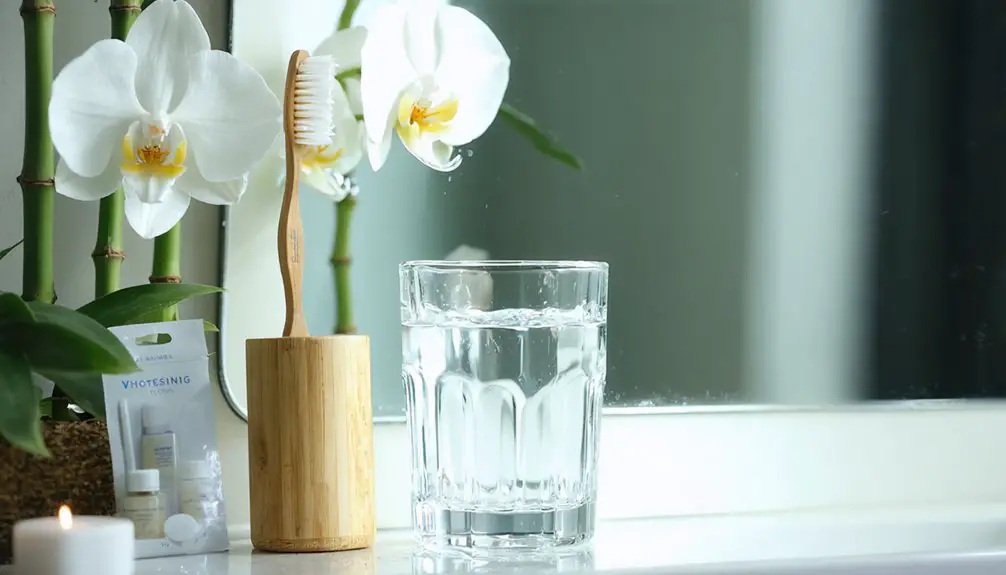
Once you’ve completed your teeth whitening treatment, proper aftercare becomes essential for maintaining those bright results long-term. Your aftercare products should include a soft-bristled toothbrush and fluoride toothpaste without abrasive ingredients.
Maintain consistent whitening routines by brushing twice daily and flossing to prevent staining between teeth.
For the first 48 hours, follow a “white diet” and stay hydrated with water to protect your newly whitened smile. If you experience sensitivity, use desensitizing toothpaste and take over-the-counter pain relievers as needed. You’ll typically notice sensitivity subsiding within 1-3 days.
To preserve your results, schedule regular dental cleanings and plan touch-up treatments every six months. Monthly maintenance sessions using short-duration applications can help maintain your bright smile between professional visits.
Foods and Habits to Avoid
To maintain your newly whitened smile, it’s crucial to understand which foods and habits can quickly undo your whitening results.
Start by avoiding staining beverages like coffee, tea, red wine, and dark sodas, which contain tannins and pigments that cling to your teeth. You’ll also want to steer clear of acidic drinks that cause enamel erosion, including citrus juices and carbonated beverages.
Watch out for deeply pigmented foods such as berries, beets, and dark sauces, as these can easily discolor your teeth.
Similarly, limit sugary and sticky treats that promote plaque buildup and staining. If you’re serious about preserving your results, you’ll need to avoid tobacco products and reduce your consumption of artificially colored foods and spicy dishes with strong pigments.
Safety Considerations and Best Practices
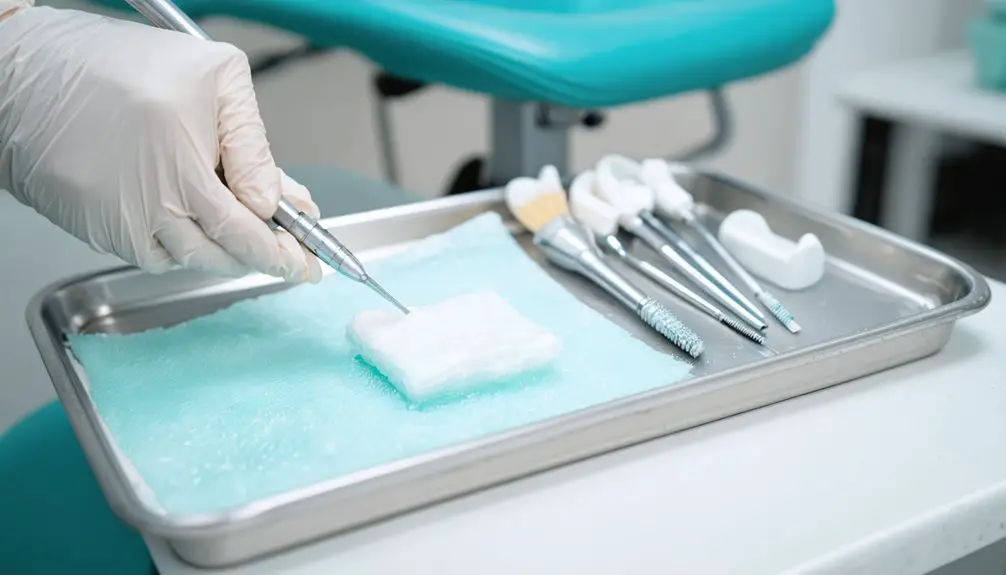
While teeth whitening is generally safe when performed correctly, consulting a dental professional before starting any treatment is crucial for best results and safety.
Your dentist will assess your oral health, identify potential risks, and recommend the most suitable whitening approach for your needs.
To protect your enamel during treatment, follow the prescribed whitening frequency and never exceed recommended application times.
If you’re using at-home products, verify you’re using custom-fitted trays and following manufacturer guidelines carefully.
Pay attention to any sensitivity or discomfort during treatment – these are signs to adjust your approach.
Professional treatments offer added safety through protective barriers and expert monitoring.
If you experience prolonged sensitivity or gum irritation, contact your dentist immediately to prevent any lasting damage to your teeth or soft tissues.
Maintaining Your Bright Smile
After investing time and effort in achieving a brighter smile, maintaining those results requires a combination of smart dietary choices and consistent oral care habits.
Despite common whitening myths, you don’t need to eliminate all colored foods – instead, make strategic dietary adjustments to protect your investment.
Use a straw when drinking pigmented beverages, and rinse your mouth with water after meals.
Brush twice daily with a soft-bristled toothbrush, and incorporate whitening toothpaste once or twice weekly.
During the critical 48 hours post-treatment, avoid acidic foods and alcohol-based mouthwash to protect your enamel.
Schedule professional touch-ups every 6-12 months, and maintain regular dental checkups.
For best results, consider switching to clear alcoholic drinks and lighter-colored alternatives when possible.
Frequently Asked Questions
Can I Whiten My Teeth While Wearing Braces or Having Dental Work?
Hold your horses – braces whitening isn’t recommended since it causes uneven results. You’ll also want to skip dental work whitening, as restorations won’t change color like natural teeth do.
How Soon After Whitening Treatment Can I Drink Hot Beverages?
You’ll need to wait 24-48 hours before drinking hot beverages to minimize whitening sensitivity and protect your results. During this time, stick to room-temperature drinks to maintain your treatment’s effectiveness.
Will Whitening Affect the Strength of My Tooth Fillings?
Like a shield against time, your filling materials stay structurally sound during whitening. While whitening products may temporarily soften surfaces, there’s no significant long-term impact on your fillings’ strength.
Is Professional Teeth Whitening Covered by Dental Insurance?
Most dental insurance plans don’t cover professional whitening since it’s considered cosmetic. You’ll typically need to pay out-of-pocket, though some plans may offer partial coverage, ranging from 20-50% of whitening costs.
Can Medications Affect the Outcome of Teeth Whitening Treatments?
Like a stubborn stain on white fabric, medications can greatly impact your whitening results. Common prescriptions affect both whitening duration and effectiveness through chemical interactions, so you’ll need professional guidance for ideal outcomes.
References
- https://www.alpinewhite.com/en/article/teeth-whitening-statistics/
- https://www.thedentalspajersey.com/blog/teeth-whitening-statistics-2024
- https://pmc.ncbi.nlm.nih.gov/articles/PMC4058574/
- https://www.heathermartinsondds.com/setting-realistic-expectations-your-teeth-whitening-timeline
- https://narrewarrendentalcare.com.au/the-truth-about-professional-teeth-whitening-is-it-worth-your-time-and-money/
- https://www.champaigndentalgroup.org/about-us/blog-articles/top-professional-teeth-whitening-techniques-2024-effective-safe
- https://lanedds.com/which-teeth-whitening-technique-lasts-longest/
- https://www.arthurglosmandds.com/blog/different-methods-of-teeth-whitening/
- https://www.culvercitydentist.com/blogs/teeth-whitening/laser-vs-zoom-whitening
- https://www.valleydentalworks.com/blog/preparing-for-teeth-whitening-what-to-do-before-your-treatment/
